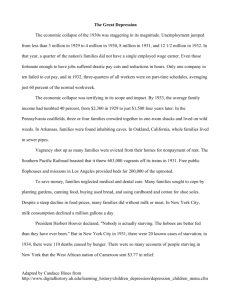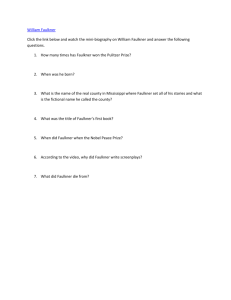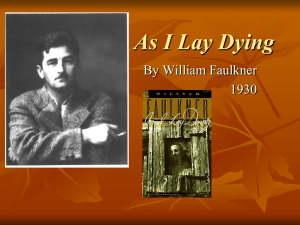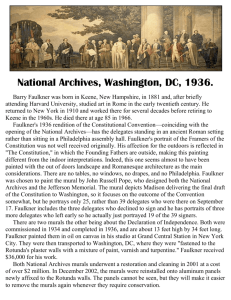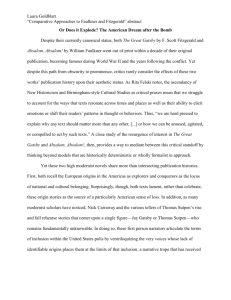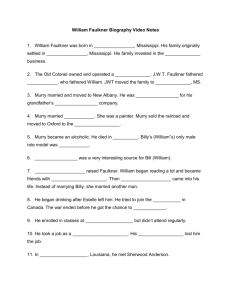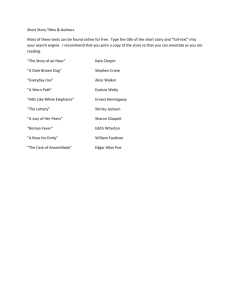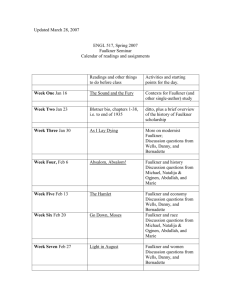Faulkner Bio and List of Publicatinos
advertisement
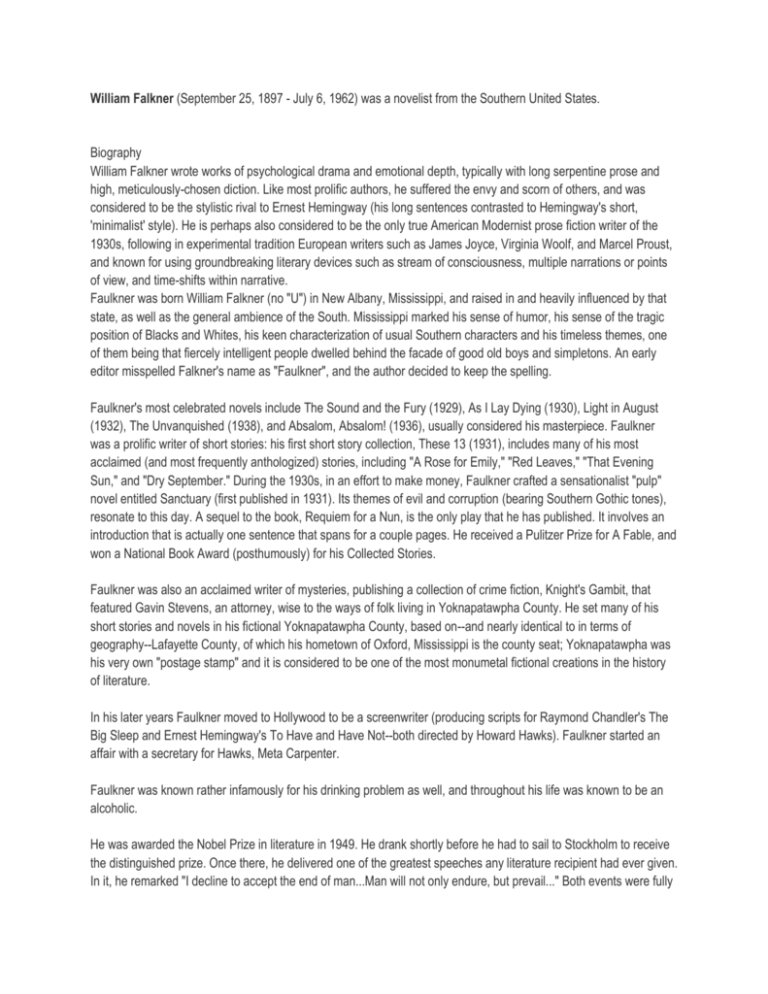
William Falkner (September 25, 1897 - July 6, 1962) was a novelist from the Southern United States. Biography William Falkner wrote works of psychological drama and emotional depth, typically with long serpentine prose and high, meticulously-chosen diction. Like most prolific authors, he suffered the envy and scorn of others, and was considered to be the stylistic rival to Ernest Hemingway (his long sentences contrasted to Hemingway's short, 'minimalist' style). He is perhaps also considered to be the only true American Modernist prose fiction writer of the 1930s, following in experimental tradition European writers such as James Joyce, Virginia Woolf, and Marcel Proust, and known for using groundbreaking literary devices such as stream of consciousness, multiple narrations or points of view, and time-shifts within narrative. Faulkner was born William Falkner (no "U") in New Albany, Mississippi, and raised in and heavily influenced by that state, as well as the general ambience of the South. Mississippi marked his sense of humor, his sense of the tragic position of Blacks and Whites, his keen characterization of usual Southern characters and his timeless themes, one of them being that fiercely intelligent people dwelled behind the facade of good old boys and simpletons. An early editor misspelled Falkner's name as "Faulkner", and the author decided to keep the spelling. Faulkner's most celebrated novels include The Sound and the Fury (1929), As I Lay Dying (1930), Light in August (1932), The Unvanquished (1938), and Absalom, Absalom! (1936), usually considered his masterpiece. Faulkner was a prolific writer of short stories: his first short story collection, These 13 (1931), includes many of his most acclaimed (and most frequently anthologized) stories, including "A Rose for Emily," "Red Leaves," "That Evening Sun," and "Dry September." During the 1930s, in an effort to make money, Faulkner crafted a sensationalist "pulp" novel entitled Sanctuary (first published in 1931). Its themes of evil and corruption (bearing Southern Gothic tones), resonate to this day. A sequel to the book, Requiem for a Nun, is the only play that he has published. It involves an introduction that is actually one sentence that spans for a couple pages. He received a Pulitzer Prize for A Fable, and won a National Book Award (posthumously) for his Collected Stories. Faulkner was also an acclaimed writer of mysteries, publishing a collection of crime fiction, Knight's Gambit, that featured Gavin Stevens, an attorney, wise to the ways of folk living in Yoknapatawpha County. He set many of his short stories and novels in his fictional Yoknapatawpha County, based on--and nearly identical to in terms of geography--Lafayette County, of which his hometown of Oxford, Mississippi is the county seat; Yoknapatawpha was his very own "postage stamp" and it is considered to be one of the most monumetal fictional creations in the history of literature. In his later years Faulkner moved to Hollywood to be a screenwriter (producing scripts for Raymond Chandler's The Big Sleep and Ernest Hemingway's To Have and Have Not--both directed by Howard Hawks). Faulkner started an affair with a secretary for Hawks, Meta Carpenter. Faulkner was known rather infamously for his drinking problem as well, and throughout his life was known to be an alcoholic. He was awarded the Nobel Prize in literature in 1949. He drank shortly before he had to sail to Stockholm to receive the distinguished prize. Once there, he delivered one of the greatest speeches any literature recipient had ever given. In it, he remarked "I decline to accept the end of man...Man will not only endure, but prevail..." Both events were fully in character. Faulkner donated his Nobel winnings, "to establish a fund to support and encourage new fiction writers", eventually resulting in the PEN/Faulkner Award for Fiction. Faulkner served as Writer-In-Residence at the University of Virginia from 1957 until his death in 1962. Works by date of first publication: Novels Soldiers Pay (1926) Mosquitoes (1927) Sartoris (1929) The Sound and the Fury (1929) As I Lay Dying (1930) Sanctuary (1931) Light in August (1932) Pylon (1935) Absalom, Absalom! (1936) The Unvanquished (1938) The Wild Palms (1939) If I Forget Thee Jerusalem (1939) The Hamlet (1940) Go Down, Moses (1942) Intruder in the Dust (1948) Requiem for a Nun (1951) A Fable (1954) The Town (1957) The Mansion (1959) The Reivers (1962) Flags in the Dust (1973) Short Stories "Landing in Luck" (1919) "The Hill" (1922) "New Orleans" "Mirrors of Chartres Street" (1925) "Damon and Pythias Unlimited" (1925) "Jealousy" (1925) "Cheest" (1925) "Out of Nazareth" (1925) "The Kingdom of God" (1925) "The Rosary" (1925) "The Cobbler" (1925) "Chance" (1925) "Sunset" (1925) "The Kid Learns" (1925) "The Liar" (1925) "Home" (1925) "Episode" (1925) "Country Mice" (1925) "Yo Ho and Two Bottles of Rum" (1925) "Music - Sweeter than the Angels Sing" "A Rose for Emily" (1930) "Honor" (1930) "Thrift" (1930) "Red Leaves" (1930) "Ad Astra" (1931) "Dry September" (1931) "That Evening Sun" (1931) "Hair" (1931) "Spotted Horses" (1931) "The Hound" (1931) "Fox Hunt" (1931) Carcassonne (1931) "Divorce in Naples" (1931) "Victory" (1931) "All the Dead Pilots" (1931) "Crevasse" (1931) "Mistral" (1931) "A Justice" (1931) "Dr. Martino" (1931) "Idyll in the Desert" (1931) "Miss Zilphia Grant" (1932) "Death Drag" (1932) "Centaur in Brass" (1932) "Once Aboard the Lugger (I)" (1932) "Lizards in Jamshyd's Courtyard" (1932) "Turnabout" (1932) "Smoke" (1932) "Mountain Victory" (1932) "There Was a Queen" (1933) "Artist at Home" (1933) "Beyond" (1933) "Elly" (1934) "Pennsylvania Station" (1934) "Wash" (1934) "A Bear Hunt" (1934) "The Leg" (1934) "Black Music" (1934) "Mule in the Yard" (1934) "Ambuscade" (1934) "Retreat" (1934) "Lo!" (1934) "Raid" (1934) "Skirmish at Sartoris" (1935) "Golden Land" (1935) "That Will Be Fine" (1935) "Uncle Willy" (1935) "Lion" (1935) "The Brooch" (1936) "Two Dollar Wife" (1936) "Fool About a Horse" (1936) "The Unvanquished" (1936) "Vendee" (1936) "Monk" (1937) "Barn Burning" (1939) "Hand Upon the Waters" (1939) "A Point of Law" (1940) "The Old People" (1940) "Pantaloon in Black" (1940) "Gold Is Not Always" (1940) "Tomorrow" (1940) "Go Down, Moses" (1941) "The Tall Men" (1941) "Two Soldiers" (1942) "Delta Autumn" (1942) "The Bear" (1942) "Afternoon of a Cow" (1943) "Shingles for the Lord" (1943) "My Grandmother Millard and General Bedford Forrest and the Battle of Harrykin Creek" (1943) "Shall Not Perish" (1943) "Appendix, Compson, 1699-1945" (1946) "An Error in Chemistry" (1946) "A Courtship" (1948) "Knight's Gambit" (1949) "A Name for the City" (1950) "Notes on a Horsethief" (1951) "Mississippi" (1954) "Sepulture South: Gaslight" (1954) "Race at Morning" (1955) "By the People" (1955) "Hell Creek Crossing" (1962) "Mr. Acarius" (1965) "The Wishing Tree" (1967) "Al Jackson" (1971) "And Now What's To Do" (1973) "Nympholepsy" (1973) "The Priest" (1976) "Mayday" (1977) "Frankie and Johnny" (1978) "Don Giovanni" (1979) "Peter" (1979) "A Portrait of Elmer" (1979) "Adolescence" (1979) "Snow" (1979) "Moonlight" (1979) "With Caution and Dispatch" (1979) "Hog Pawn" (1979) "A Dangerous Man" (1979) "A Return" (1979) "The Big Shot" (1979) "Once Aboard the Lugger (II)" (1979) "Dull Tale" (1979) "Evangeline" (1979) "Love" (1988) "Christmas Tree" (1995) "Rose of Lebanon" (1995) "Lucas Beauchamp" (1999) William Faulkner (1897-1962), who came from an old southern family, grew up in Oxford, Mississippi. He joined the Canadian, and later the British, Royal Air Force during the First World War, studied for a while at the University of Mississippi, and temporarily worked for a New York bookstore and a New Orleans newspaper. Except for some trips to Europe and Asia, and a few brief stays in Hollywood as a scriptwriter, he worked on his novels and short stories on a farm in Oxford. In an attempt to create a saga of his own, Faulkner has invented a host of characters typical of the historical growth and subsequent decadence of the South. The human drama in Faulkner's novels is then built on the model of the actual, historical drama extending over almost a century and a half Each story and each novel contributes to the construction of a whole, which is the imaginary Yoknapatawpha County and its inhabitants. Their theme is the decay of the old South, as represented by the Sartoris and Compson families, and the emergence of ruthless and brash newcomers, the Snopeses. Theme and technique - the distortion of time through the use of the inner monologue are fused particularly successfully in The Sound and the Fury (1929), the downfall of the Compson family seen through the minds of several characters. The novel Sanctuary (1931) is about the degeneration of Temple Drake, a young girl from a distinguished southern family. Its sequel,Requiem For A Nun (1951), written partly as a drama, centered on the courtroom trial of a Negro woman who had once been a party to Temple Drake's debauchery. In Light in August(1932), prejudice is shown to be most destructive when it is internalized, as in Joe Christmas, who believes, though there is no proof of it, that one of his parents was a Negro. The theme of racial prejudice is brought up again in Absalom, Absalom! (1936), in which a young man is rejected by his father and brother because of his mixed blood. Faulkner's most outspoken moral evaluation of the relationship and the problems between Negroes and whites is to be found in Intruder In the Dust (1948). In 1940, Faulkner published the first volume of the Snopes trilogy, The Hamlet, to be followed by two volumes, The Town (1957) and The Mansion (1959), all of them tracing the rise of the insidious Snopes family to positions of power and wealth in the community. The reivers, his last - and most humorous work, with great many similarities to Mark Twain's Huckleberry Finn, appeared in 1962, the year of Faulkner's death.
